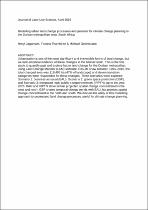 ResearchSpace
ResearchSpace
Modelling urban land change processes and patterns for climate change planning in the Durban metropolitan area, South Africa
JavaScript is disabled for your browser. Some features of this site may not work without it.
- ResearchSpace
- →
- Research Publications/Outputs
- →
- Journal Articles
- →
- View Item
| dc.contributor.author |
Jagarnath, M

|
|
| dc.contributor.author |
Thambiran, Tirusha

|
|
| dc.contributor.author |
Gebreslasie, M

|
|
| dc.date.accessioned | 2019-08-14T06:55:20Z | |
| dc.date.available | 2019-08-14T06:55:20Z | |
| dc.date.issued | 2019-04 | |
| dc.identifier.citation | Jagarnath, M., Thambiran, T., and Gebreslasie, M. 2019. Modelling urban land change processes and patterns for climate change planning in the Durban metropolitan area, South Africa. Journal of Land Use Science, v14(1), pp 81-109. | en_US |
| dc.identifier.issn | 1747-423X | |
| dc.identifier.uri | https://www.tandfonline.com/doi/full/10.1080/1747423X.2019.1610809 | |
| dc.identifier.uri | https://doi.org/10.1080/1747423X.2019.1610809 | |
| dc.identifier.uri | http://hdl.handle.net/10204/11079 | |
| dc.description | Copyright: 2019 Taylor & Francis Group. Due to copyright restrictions, the attached PDF file only contains the abstract of the full text item. For access to the full text item, kindly consult the publisher's website. | en_US |
| dc.description.abstract | Urbanization is one of the most significant and irreversible forms of land change, but we lack empirical evidence of these changes in the Global South. This is the first study to quantify past and explore future land change for the Durban metropolitan, using Land Change Modeler (LCM) software. Results show between 1994–2016, the total changed area was 118,403 ha (47% of landscape) and eleven transition categories were responsible for these changes. Three scenarios were explored: Scenario 1: business as usual (BAU), Scenario 2: green space protection (GSP), and Scenario 3: integrated rapid public transport network (IRPTN), up to the year 2076. BAU and IRPTN show similar projected spatial change concentrated in the west and north. GSP shares temporal change trends with BAU, but projects spatial change concentrated in the north and south. We discuss the utility of this modelling approach to understand land change processes useful for climate change planning. | en_US |
| dc.language.iso | en | en_US |
| dc.publisher | Taylor & Francis Group | en_US |
| dc.relation.ispartofseries | Worklist;22434 | |
| dc.subject | Adaptation | en_US |
| dc.subject | Cities | en_US |
| dc.subject | Future studies | en_US |
| dc.subject | Land use | en_US |
| dc.subject | Mitigation | en_US |
| dc.subject | Spatial planning | en_US |
| dc.title | Modelling urban land change processes and patterns for climate change planning in the Durban metropolitan area, South Africa | en_US |
| dc.type | Article | en_US |
| dc.identifier.apacitation | Jagarnath, M., Thambiran, T., & Gebreslasie, M. (2019). Modelling urban land change processes and patterns for climate change planning in the Durban metropolitan area, South Africa. http://hdl.handle.net/10204/11079 | en_ZA |
| dc.identifier.chicagocitation | Jagarnath, M, Tirusha Thambiran, and M Gebreslasie "Modelling urban land change processes and patterns for climate change planning in the Durban metropolitan area, South Africa." (2019) http://hdl.handle.net/10204/11079 | en_ZA |
| dc.identifier.vancouvercitation | Jagarnath M, Thambiran T, Gebreslasie M. Modelling urban land change processes and patterns for climate change planning in the Durban metropolitan area, South Africa. 2019; http://hdl.handle.net/10204/11079. | en_ZA |
| dc.identifier.ris | TY - Article AU - Jagarnath, M AU - Thambiran, Tirusha AU - Gebreslasie, M AB - Urbanization is one of the most significant and irreversible forms of land change, but we lack empirical evidence of these changes in the Global South. This is the first study to quantify past and explore future land change for the Durban metropolitan, using Land Change Modeler (LCM) software. Results show between 1994–2016, the total changed area was 118,403 ha (47% of landscape) and eleven transition categories were responsible for these changes. Three scenarios were explored: Scenario 1: business as usual (BAU), Scenario 2: green space protection (GSP), and Scenario 3: integrated rapid public transport network (IRPTN), up to the year 2076. BAU and IRPTN show similar projected spatial change concentrated in the west and north. GSP shares temporal change trends with BAU, but projects spatial change concentrated in the north and south. We discuss the utility of this modelling approach to understand land change processes useful for climate change planning. DA - 2019-04 DB - ResearchSpace DP - CSIR KW - Adaptation KW - Cities KW - Future studies KW - Land use KW - Mitigation KW - Spatial planning LK - https://researchspace.csir.co.za PY - 2019 SM - 1747-423X T1 - Modelling urban land change processes and patterns for climate change planning in the Durban metropolitan area, South Africa TI - Modelling urban land change processes and patterns for climate change planning in the Durban metropolitan area, South Africa UR - http://hdl.handle.net/10204/11079 ER - | en_ZA |





